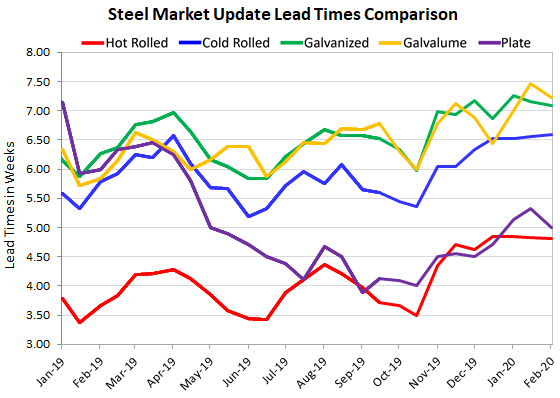SMU Data and Models

Steel Mill Lead Times: Flat at Healthy Level
Written by Tim Triplett
February 6, 2020
Mill lead times for spot orders of flat rolled steel extended by more than a week during last year’s fourth quarter, but so far this year have been fairly flat. The average lead time for orders of hot roll is now a bit less than five weeks, cold roll around six and a half weeks and coated steels near seven weeks. Plate is at five weeks.
Comparing the data, the average lead time for spot orders of hot rolled last week was 4.81 weeks, little changed 4.85 in early January. Cold rolled last week was at 6.59 weeks, versus 6.52 weeks the month prior. Galvanized was at 7.08, down just slightly from 7.15, while Galvalume was at 7.22 weeks. The average plate lead time last week was 5.00 weeks, slightly shorter than the 5.33 in SMU’s survey in mid-January.
Lead times for steel delivery are an indicator of demand at the mill level. The longer the lead time, the busier the mill. With lead times registering little change for several weeks, it’s difficult to gauge market direction. Currently, the numbers suggest relatively healthy order levels.

Note: These lead times are based on the average from manufacturers and steel service centers who participated in this week’s SMU market trends analysis. Our lead times do not predict what any individual may get from any specific mill supplier. Look to your mill rep for actual lead times. Our lead times are meant only to identify trends and changes in the marketplace. To see an interactive history of our Steel Mill Lead Times data, visit our website here.

Tim Triplett
Read more from Tim TriplettLatest in SMU Data and Models

SMU’s June at a glance
A look at SMU data for the month of June.

SMU Survey: Buyers’ Sentiment rebounds from multi-year low
Both of SMU’s Steel Buyers’ Sentiment Indices edged higher this week. Current Sentiment rebounded from a near five-year low, while Future Sentiment rose to a two-month high

SMU flat-rolled market survey results now available
SMU’s latest steel buyers market survey results are now available on our website to all premium members.

SMU Survey: Sheet lead times pull back after early-June blip, plate holds
Following the uptick seen two weeks ago, lead times eased this week for all four sheet products tracked by SMU, while plate lead times held steady, according to this week’s market survey.

SMU Survey: Pricing power abruptly shifts to steel buyers
The majority of steel buyers responding to our latest market survey say domestic mills are more willing to talk price on sheet and plate products than they were earlier this month. Sheet negotiation rates rebounded across the board compared to early June, while our plate negotiation rate hit a full 100%.
